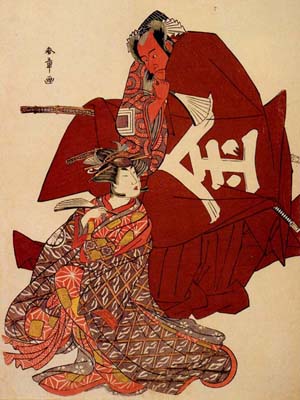| KUMO NO HYďSHIMAI |
| Dance title | Kumo no Hy˘shimai Waga Sekogakoi no Aizuchi |
| Authors | Sakurada Jisuke I (lyrics) Kineya Sakichi I (music) Fujima Kanbei (choreography) |
| History |
The dance-drama "Waga Sekogakoi no Aizuchi" (commonly called "Kumo no Hy˘shimai") was permiered in the 11th lunar month of 1781 at the Nakamuraza and performed within the kaomise program "Shitenn˘ Tonoi no Kisewata" [casting]. It went into oblivion for more than 173 years and was successfully revived by Nakamura Utaemon VI in February 1955 [casting]. It was staged within the program of the 2nd edition of the Tsubomikai, a study group led by Nakamura Utaemon VI [more details]. |
| Key words |
Aragoto Chisuji no Ito Hy˘shimai Kaomise Buy˘ Kumo Kumo no Sei Kumo Taiji Minamoto Yorimitsu Raik˘ Sakata Kintoki Shiraby˘shi Shitenn˘ Shitenn˘mono Shosagoto Tsubomikai Urabe Suetake Usui Sadamitsu Watanabe Tsuna Yamai Hachimaki |
| Summary |
The scene is a delapidated palace, said to be haunted by a specter, and Minamoto no Yorimitsu* has been sent to investigate. The dancer Tsumagiku, in reality the spirit of a giant spider, makes an unexpected appearance and dances with Yorimitsu, but one of Yorimitsu's warriors notices that although she looks like a beautiful woman, the shadow she casts is that of a spider. Tsumagiku disappears and a lighter scene follows in which one of Kabuki's creatures makes its appearance-a human-sized spider which crawls nimbly around the stage and poses with its hairy legs over the actors' shoulders. When it disappears it is replaced by the Spider Woman in her real guise-a hideously grotesque woman with long shaggy hair, black kumadori makeup lines and a red venomous tongue. Text courtesy of Jean Wilson (January 1999) (*) This warrior is also nicknamed Raik˘, which is the "Chinese" reading of Yorimitsu. |
| Comments |
The excitement of this dance came from Tsumagiku throwing out streamers of long, sticky web-like threads over and over. The whole stage was full of them and they got caught up in the actors' wigs, costumes and swords and some fell on audience members. It was fascinating to watch the stage hands furiously winding up balls of the threads and trying to get them out of the way before an actor stepped on them. Text courtesy of Jean Wilson (January 1999) |
 |
|
The actors Ichikawa Danjűr˘ V and Segawa Kikunoj˘ III playing the roles of Sakata Kintoki and the shiraby˘shi Tsumagiku (in reality the spirit of a ground spider) in the dance-drama "Waga Sekogakoi no Aizuchi" (commonly called "Kumo no Hy˘shimai"), which was staged within the kaomise program "Shitenn˘ Tonoi no Kisewata" and performed in the 11th lunar month of 1781 at the Nakamuraza (print made by Katsukawa Shunj˘) |
|
|
| Contact | Main | Top | Updates | Actors | Plays | Playwrights | Programs | Links | FAQ | Glossary | Chronology | Illustrations | Prints | Characters | Derivatives | Theaters | Coming soon | News |